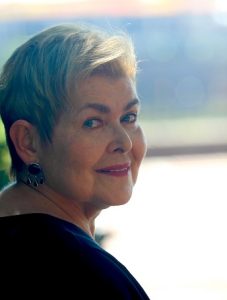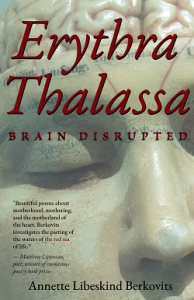Art And Science: Two Sides Of The Same Coin
 Annette Libeskind Berkovits
Annette Libeskind Berkovits
It was the poetic randomness of the cosmos that threw me into a terrifying whirl on November 12, 2014. My perfectly healthy adult son suffered a devastating hemorrhagic stroke. I had to do everything in my power to keep myself from falling apart. Sitting for hours in waiting rooms and hospital corridors awaiting the life or death verdict, I turned to my most effective solace: writing
I scribbled and scribbled in my notes function on my IPhone to keep tears and pain at bay. Eventually, the poems I wrote found an arc; they told the story of a mother’s grief and guilt and acceptance. My chapbook—a memoir in accessible poetry form— released on the sixth anniversary of my son’s stroke is a blend of my science background and my love of words. The poem from which the entire collection derived its name Erythra Thalassa blends my knowledge of the brain’s structure with the mystery it holds:
Erythra Thalassa
One Israelite crossing
on a life and death journey
a sea of crimson, bubbling,
rushing through the great rifts
between the hemispheres
flooding the sulci and gyri.
In the myriad gray folds
no neuron, no synapse,
no astrocyte,
no oligodendrocyte,
no microglia left dry.
Epic flood.
Then all is silenced.
No cheering on the other shore.
How long the deafening
stillness? How long the ears
shuttered closed?
How long will eyelids
veil his light?
I have been asked time and again how and why does my professional training align with writing. I started my career as a cancer researcher at the Sloan Kettering Cancer Research Institute in New York and, later, a three decade career in wildlife conservation. Both required a scientific background. I have never found anything conflicting between the two disciplines. Indeed, I found that they mixed in my brain to produce expressions in both areas worthy of pursuing. My instinct to express emotions and ideas in writing was always present and often sparked by a scientific concept.
Most writers are neither scientists, nor think of themselves as such, conversely, most scientists don’t spend their days spinning plots or writing verses. There is, however, a greater number of people than you’d imagine who happen to be and do both. I am both a writer and a scientist. I have been extremely fortunate to have found, via various online writing courses, several writers who, like me, blend art and science as a matter of course. My first encounter in a Gotham Writers workshop with a kindred spirit was a botanist who was writing a wonderful memoir of a community garden in a blighted neighborhood. I was one of his lucky beta readers. His narrative enabled me to learn amazing truths about plants and people.
 In my MOOC International Writing Program (Massive Online Open Course) I met three wonderful scientist-authors—a physician and two environmental specialists— one in New Zealand, one in Ireland and one only a couple of hours away from me, in New York state. Perhaps it’s our combination of scientific and artistic sensibilities that has brought us together and nourished our friendship. The encouragement of these friends helped me bring Erythra Thalassa: Brain Disrupted to completion. The brain is as uncharted a territory as distant galaxies. It is an amazing organ full of mystery. As much as we know about the brain, it is likely only a minuscule portion of what we yet have to learn. In that, lies the excitement of discovery and beauty.
In my MOOC International Writing Program (Massive Online Open Course) I met three wonderful scientist-authors—a physician and two environmental specialists— one in New Zealand, one in Ireland and one only a couple of hours away from me, in New York state. Perhaps it’s our combination of scientific and artistic sensibilities that has brought us together and nourished our friendship. The encouragement of these friends helped me bring Erythra Thalassa: Brain Disrupted to completion. The brain is as uncharted a territory as distant galaxies. It is an amazing organ full of mystery. As much as we know about the brain, it is likely only a minuscule portion of what we yet have to learn. In that, lies the excitement of discovery and beauty.
So what is it that unites these seemingly disparate fields? Fundamentally, the answer is both simple and exalted: the search for truth. Both disciplines engage in a relentless search for solutions, for answers to problems. Without creativity no scientist could come up with varied hypotheses, or find ways to test them.
Without any science understanding, I could not have grasped the link between the erythrocytes in our blood and the imaginative name of the Red Sea whose color is derived from algae. If it weren’t for the science of pigments, artists could not render the world in exquisite colors. Poets like Oliver Wendell Holmes writing about the chambered nautilus, or Edith Nesbit about the exquisite design of seashells, or Mary Oliver’s poems about sunflowers, are just the converse of conchologists who describe them and give us insight into the morphology of mollusks, or mathematicians comparing the Fibonacci formula to the spiral chambers of the nautilus, the sunflower’s face, or distant galaxies.
You needn’t be a scientist to attempt blending art and science. If you read anything science related—new discoveries, facts, phenomena— and think about them, they may just inspire you to write a poem or a story. fes
To learn more about how the chapbook came into existence and to check out Annette’s other books please visit:
Website: http://www.annetteberkovits.com
Buy the book: lhere
ANNETTE LIBESKIND BERKOVITS was born in Kyrgyzstan and grew up in postwar Poland and the fledgling state of Israel before coming to the United States at age sixteen. Her professional background is in the biological sciences and education. Her books include Confessions of an Accidental Zoo Curator (2017) and In the Unlikeliest of Places: How Nachman Libeskind Survived the Nazis, Gulags, and Soviet Communism (2016). Her stories and poems have appeared in Silk Road Review: a Literary Crossroads; Persimmon Tree; American Gothic: a New Chamber Opera; Blood & Thunder: Musings on the Art of Medicine; and in The Healing Muse.
Category: Contemporary Women Writers, How To and Tips

























